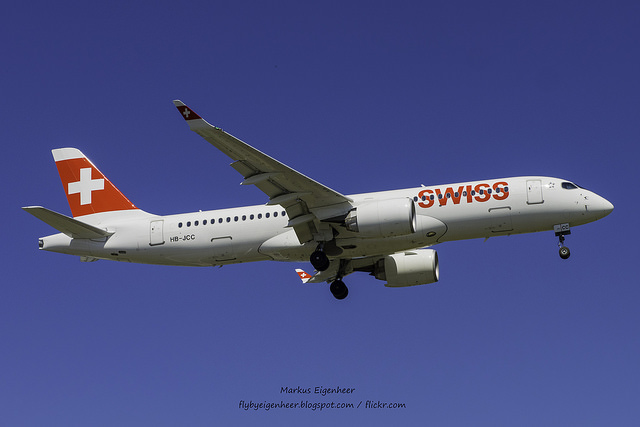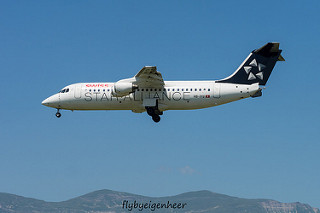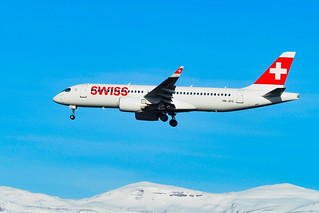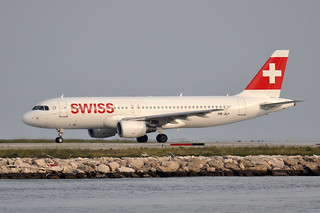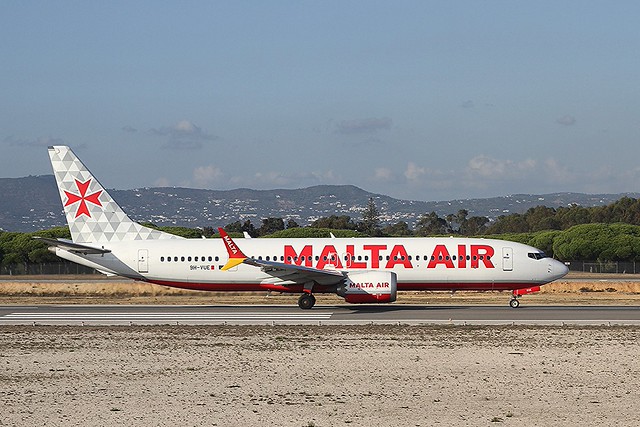Swiss BCS3 near Paris on Oct 15th 2019, engine shut down in flight after uncontained failure
Last Update: May 4, 2022 / 19:15:10 GMT/Zulu time
Incident Facts
Date of incident
Oct 15, 2019
Classification
Incident
Airline
Swiss
Flight number
LX-359
Departure
London Heathrow, United Kingdom
Destination
Geneva, Switzerland
Aircraft Registration
HB-JCC
Aircraft Type
Airbus A220-300
ICAO Type Designator
BCS3
The airline confirmed an irregularity with one of the engines of flight LX-359. As immediate reaction the airline announced to keep all their 29 BCS1 and BCS3 aircraft on the ground for additional inspection of the engines. All passengers, affected by cancelled flights as result of these additional inspections, will be rebooked onto other flights.
On Oct 15th 2019 at 15:32Z the French BEA reported the occurrence, an engine failure on the flight Heathrow to Geneva with diversion to Paris, was rated a serious incident, investigators have been dispatched on site. The investigation was delegated to the NTSB.
On Oct 26th 2019 Transport Canada issued an Emergency Airworthiness Directive (EAD) CF-2019-37 (subsequently also distributed by Switzerland's BAZL) stating:
Several occurrences of engine in-flight shutdowns (IFSDs) were reported on Airbus Canada Limited Partnership BD-500 family aeroplanes. Investigations are ongoing to determine the root cause. Preliminary investigation results indicate high altitude climbs at higher thrust settings for engines with certain thrust ratings may be a contributor. This condition, if not corrected, could lead to an uncontained failure of the engine and damage to the aeroplane.
To address this potentially unsafe condition, this AD introduces a new Aircraft Flight Manual (AFM) limitation and normal procedure to limit the engine N1 setting to 94% while above 29000 feet.
In the EAD required amendment to the Aircraft Flight Manual it is stated: "Caution: Before initiation of step climbs above 29000 feet, the autothrottle must be selected off to respect the 94% N1 limitation."
On Mar 31st 2020 the FAA released another Airworthiness Directive AD-2020-07-02 arguing:
The FAA has received reports of four instances of IFSDs occurring on the affected model turbofan engines since 2019.
In response to the two IFSDs that occurred in July and September 2019, and in response to ongoing investigations of these IFSDs, the FAA issued AD 2019-19-11 (84 FR 50719, September 26, 2019), to perform inspections of the LPC R1 to prevent failures. The FAA subsequently superseded AD 2019-19-11, issuing AD 2019-21-11 (84 FR 57813, October 29, 2019) in response to another IFSD and to expand the population of affected engines that needed inspection of the LPC R1. Since the effective date of AD 2019-21-11, another IFSD occurred in February 2020. Analysis by the manufacturer determined that the LPC vane schedules were putting the engine in a condition to experience an acoustic resonance that damages the LPC R1, which then leads to LPC R1 failure. In response, the manufacturer updated the EEC FADEC software to improve vane scheduling to avoid acoustic resonance.
This condition, if not addressed, could result in uncontained release of the LPC R1, damage to the engine, and damage to the airplane. The FAA is issuing this AD to address the unsafe condition on these products.
On Dec 17th 2020 the NTSB released their preliminary report stating:
On October 15, 2019, about 0640 coordinated universal time, Swiss International Airlines flight LX359, an Airbus A220-300, HB-JCC, experienced an uncontained No. 1 (left) engine failure over northwest Belgium. The passengers and crew were not injured during the incident. The airplane was operated as an international commercial flight.
According to the crew statements, the engine failure occurred during climb, while the airplane was passing through FL348. The crew members heard a bang and reported a decrease in left engine N1 speed. A couple of minutes later, there was a louder bang, the left engine N1 speed decreased to zero, and an exhaust gas temperature warning was displayed. The crew followed emergency procedures and diverted to Charles de Gaulle Airport (LFPG), Paris, France.
A post flight inspection of the left engine revealed a hole in the low pressure compressor (LPC) case and the LPC stage 1 rotor was separated and missing. The flight data recorder was secured, and the engine was removed for examination.
In accordance with ICAO Annex 13, the National Transportation Safety Board (NTSB) accepted the delegation of this investigation from the French Bureau d'Enquêtes et d'Analyses pour la Sécurité de l'Aviation Civile (BEA) and the Air Accident Investigation Unit (AAIU) of Belgium, who appointed Accredited Representatives.
The four mentioned occurences are: Incident: Swiss BCS3 near Paris on Jul 25th 2019, engine shut down in flight, Incident: Swiss BCS3 near Geneva on Sep 16th 2019, uncontained engine failure, Incident: Swiss BCS3 near Paris on Oct 15th 2019, engine shut down in flight and Incident: Baltic BCS3 near Bordeaux on Feb 12th 2020, uncontained engine failure.
On May 4th 2022 the NTSB released their final report concluding the probable causes of the incident were:
A No. 1 (left) engine low pressure compressor (LPC) stage 1 integrally bladed rotor (IBR) separation due to a high cycle fatigue crack (HCF) that originated at the runout of an airfoil leading edge root radius. The HCF crack developed because of a mechanically coupled LPC stage 3 and stage 1 IBR mode excitation and blade flutter response. The excitation was driven by an acoustic tone generated by turbulent airflow passing over the 2.5 bleed valve duct cavity while the engine was operating at high speeds in specific flight conditions. A primary contributor to the failure mode was an electronic engine control (EEC) software update that changed the LPC vane schedule and increased the likelihood of LPC stage 1 IBR blade flutter onset within the engine operating range.
The NTSB analysed:
The No. 1 engine low pressure compressor (LPC) stage 1 integrally bladed rotor (IBR) failure was caused by a stage 1 IBR high cycle fatigue crack that originated at the runout of an airfoil leading edge root radius. Multiple analytical methods, including two-dimensional (2D) computational fluid dynamics (CFD), acoustic testing, and instrumented flight testing identified a coupled LPC stage 3 and stage 1 IBR instability caused by an acoustic coincidence with the 2.5 bleed valve duct cavity. At high engine N1 speeds, the stage 3 IBR blade tips generate vortices/turbulent airflow and given the right conditions, the turbulent airflow can create an acoustic tone as it passes over the 2.5 bleed valve duct cavity, located immediately aft of the LPC stage 3 IBR (Figure 1). The acoustic tone drove a LPC stage 3 IBR blade 1st bending mode excitation that was then mechanically transferred through the LPC module and excited a LPC stage 1 IBR stiffwise bending mode that was present at the same approximate frequency. The resultant stresses on the LPC stage 1 IBR blades exceeded material limits and subsequently led to crack formation and eventual progression to overload failure.
Factors that contributed to the LPC stage 3 and stage 1 IBR acoustic coincidence and blade excitation within the engine operating range were: installation of electronic engine control (EEC) Software V2.11.7.2 and the low time rub in period on the LPC IBR blade tip clearances.
EEC Software V2.11.7.2 changed the LPC inlet guide vane schedule to rotate the IGV’s in the closed direction at specific high power engine conditions to improve engine stall/surge margin. The revised vane schedule inadvertently created conditions that were favorable for generation of the 2.5 bleed valve duct cavity acoustic tone and IBR mode excitation.
New engines have tighter clearances between the LPC IBR blade tips and the outer air seals. The reduced clearance created unsteady loading at the blade tip region and resulted in stronger acoustic coupling/flutter response. After a rub in period, the clearance increases, and the occurrence of flutter onset is reduced.
There were three PW1524G-3 and one PW1521G-3 LPC stage 1 IBR separation events between July 25, 2019 and February 12, 2020 that occurred on multiple operators. The incident detailed in this investigation was the third PW1500G series LPC stage 1 IBR failure. The engine parameters at the time of each of the events and the resulting engine damage were consistent. Additional information about the failure mode and investigation process are available in the investigation dockets for the first two incidents, NTSB investigation numbers ENG19IA029 and ENG19IA034.
Aircraft Registration Data
Incident Facts
Date of incident
Oct 15, 2019
Classification
Incident
Airline
Swiss
Flight number
LX-359
Departure
London Heathrow, United Kingdom
Destination
Geneva, Switzerland
Aircraft Registration
HB-JCC
Aircraft Type
Airbus A220-300
ICAO Type Designator
BCS3
This article is published under license from Avherald.com. © of text by Avherald.com.
Article source
You can read 2 more free articles without a subscription.
Subscribe now and continue reading without any limits!
Read unlimited articles and receive our daily update briefing. Gain better insights into what is happening in commercial aviation safety.
Send tip
Support AeroInside by sending a small tip amount.
Related articles
Swiss BCS3 at Porto on Jul 15th 2018, spoiler warning during takeoff run with insufficient thrust
A Swiss International Airlines Bombardier C-Series CS-300 (also now known as Airbus A220), registration HB-JCC performing flight LX-2077 from Porto…
Swiss BCS3 near Geneva on Dec 21st 2018, engine problem
A Swiss International Airlines Bombardier C-Series CS-300, registration HB-JCC performing flight LX-2200 from Geneva (Switzerland) to Marrakesh…
Swiss RJ1H enroute on Sep 3rd 2016, fumes in cockpit and cabin
A Swiss Global Airlines Avro RJ-100, registration HB-IYU performing flight LX-2813 from Geneva to Zurich (Switzerland) with 88 passengers and 4 crew,…
Swiss BCS3 near Zurich on Jul 24th 2022, loss of cabin pressure
A Swiss Bombardier C-Series CS-300, registration HB-JCG performing positioning flight LX-5141 from Ibiza,SP (Spain) to Zurich (Switzerland) with just…
Swiss BCS3 near Geneva on Sep 16th 2019, uncontained engine failure
A Swiss International Airlines Bombardier C-Series CS-300, registration HB-JCA performing flight LX-358 from Geneva to London Heathrow,EN (UK) with…
Swiss BCS1 near Geneva on Feb 22nd 2022, brakes problem
A Swiss Bombardier C-Series CS-100, registration HB-JBE performing flight LX-1082 from Geneva (Switzerland) to Frankfurt/Main (Germany), was enroute…
Swiss A320 at Zurich on Jun 13th 2021, fumes in cockpit
A Swiss Airbus A320-200, registration HB-JLP performing flight LX-967 from Berlin (Germany) to Zurich (Switzerland) with 19 passengers and 7 crew,…
Newest articles
Malta B38M at Krakow on Dec 8th 2025, sun visor temporarily shuts engine down
An Air Malta Boeing 737-8 MAX on behalf of Ryanair, registration 9H-VUE performing flight FR-3505 from Krakow (Poland) to Milan Bergamo (Italy), was…
Hokkaido AT42 at Okushiri on Dec 16th 2025, problems with left aileron
A Hokkaido Air System Avions de Transport Regional ATR-42-600 on behalf of JAL Japan Airlines, registration JA13HC performing flight JL-2891 from…
Subscribe today
Are you researching aviation incidents? Get access to AeroInside Insights, unlimited read access and receive the daily newsletter.
Pick your plan and subscribePartner

ELITE Simulation Solutions is a leading global provider of Flight Simulation Training Devices, IFR training software as well as flight controls and related services. Find out more.
SafetyScan Pro provides streamlined access to thousands of aviation accident reports. Tailored for your safety management efforts. Book your demo today
AeroInside Blog
Popular aircraft
Airbus A320Boeing 737-800
Boeing 737-800 MAX
Popular airlines
American AirlinesUnited
Delta
Air Canada
Lufthansa
British Airways





